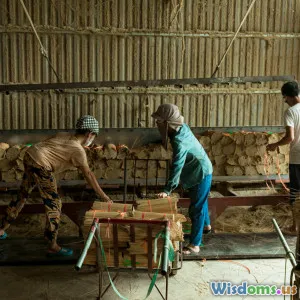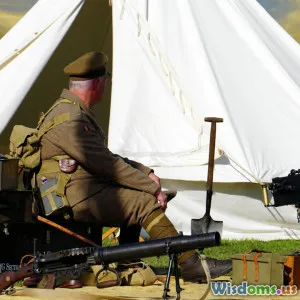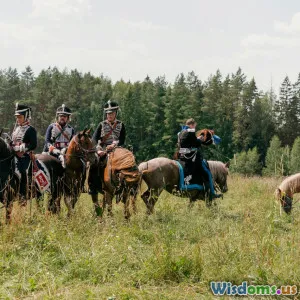
Peasant Revolts That Sparked the Chinese Communist Victory
9 min read Explore how peasant revolts galvanized the Chinese Communist Party's rise and ultimate victory in China. (0 Reviews)
Peasant Revolts That Sparked the Chinese Communist Victory
The massive landscape of China in the early 20th century was not just defined by imperial fall and warlord clashes but by countless peasant revolts that set the stage for the rise of the Chinese Communist Party (CCP). These revolts weren’t mere sporadic outbursts of unrest; they were the lifeblood of a sweeping socio-political transformation. Understanding these peasant uprisings reveals how grassroots movements fueled the Communist revolution and contributed decisively to its victory.
Introduction: The Forgotten Engines of Revolution
When most people think of the Chinese Communist Party’s victory in 1949, images of the Long March or Mao Zedong's charismatic leadership often come to mind. However, an essential but sometimes overlooked factor was the relentless spirit of millions of impoverished peasants rising up in protest against exploitation and feudal oppression. These movements planted the seeds of revolution, provided manpower and ideological grounding for the CCP, and weakened the ruling Nationalist regime.
Far from spontaneous, peasant revolts were deeply rooted in systemic inequities exacerbated by exploitative landlords, unjust taxation, and colonial pressures. In fact, one can argue that these revolts were the vital spark of the Chinese Communist victory, illustrating a classic example of how societal change often arises from the grassroots.
Causes and Conditions Fueling Peasant Revolts
Economic Exploitation and Feudal Landlordism
For centuries, China’s rural masses lived under economic hardship. The landlord system extracted heavy rents and interest, trapping peasants in near-perpetual debt. Over 80% of China’s population were peasants during the 1920s and 1930s, yet they owned a shrinking fraction of the land. These poor agrarian conditions prompted widespread dissatisfaction.
The Impact of War and Political Fragmentation
Between the end of the Qing dynasty in 1911 and the Communist victory in 1949, China endured foreign invasions, internal wars, and political fragmentation. The chaos and brutal warfare devastated rural regions, lowered harvests, and increased insecurity. Peasants often bore the brunt of conscription, pillaging, and the destruction of farmland.
The Influence of Communist Ideology
Unlike previous revolts that aimed simply at resisting oppressive landlords, peasant movements associated with the CCP embraced radical ideas promoting land reform, equality, and collectivization. Mao Zedong’s theories emphasized the peasantry as the revolutionary class rather than the urban proletariat, thus reorienting Communist strategies to rural mobilization.
Key Peasant Revolts That Shaped the Revolution
The Hunan Peasant Uprisings (1927-1931)
Hunan province was one of the earliest hotbeds of peasant militancy. The uprisings there erupted partly due to unbearable taxation and landlord exploitation. The Communist Party, although a minor political force at this time, actively encouraged organizing peasants into self-defense units and armed bands. These armed peasant groups disrupted Nationalist control, creating liberated zones where reforms were tested.
The Autumn Harvest Uprising (1927)
One of the seminal events was the Autumn Harvest Uprising led by Mao Zedong himself. Although the rebellion initially faced military defeat, it marked a turning point in CCP strategy. Mao’s experience convinced him that focusing on rural guerrilla warfare and mobilization was crucial. This insight redirected the CCP to build strongholds in the countryside, thus nurturing conditions for eventual victory.
The Jiangxi Soviet and Land Reform
The Jiangxi Soviet (1931-1934), a self-declared Communist state, formalized radical land redistribution. Peasants seized land from landlords, and the CCP implemented progressive policies such as banning usury and establishing peasant militias. The land reforms significantly improved living standards and loyalty among peasants, making the region a powerful revolutionary base.
Resistance during the Japanese Invasion (1937-1945)
The Japanese invasion during World War II further complicated the rural struggle but also galvanized peasants under Communist leadership. The CCP portrayed itself as the true defender of peasant interests against both Japanese invaders and Nationalist forces. In many rural areas, Communist guerrillas provided protection, education, and social services—strengthening their legitimacy tremendously.
How Peasant Revolts Exploited Nationalist Weaknesses
Nationalist Government’s Failure to Address Peasant Grievances
The Kuomintang (KMT) government, led by Chiang Kai-shek, consistently failed to implement meaningful land reform or reduce corruption in rural areas. Their reliance on landlords for control alienated peasants further, enabling Communist propaganda to resonate deeply.
Military Overextension and Loss of Popular Support
The Nationalists’ military suppression of peasant dissent and heavy taxation to support prolonged wars drained their resources and alienated civilians. This lack of popular support proved fatal during the civil war.
The Strategic Advantage of Guerrilla Warfare and Peasant Militias
Communist-led peasant militias leveraged knowledge of local terrain and tight community networks. This intimate connection with rural populations enabled the CCP to conduct effective guerrilla warfare against better-equipped Nationalist armies.
Real-World Impact and Legacy
The effect of peasant revolts was not only critical to the Chinese Communist victory but transformed rural China structurally. Post-1949, land reform became state policy with sweeping redistribution of land from landlords to peasants, fundamentally altering Chinese society. These changes helped increase agricultural productivity initially and laid the groundwork for the communist state’s future policies.
Moreover, Mao’s focus on the peasantry challenged Soviet Communist orthodoxy, highlighting a new path to socialism that emphasized the revolutionary potential of rural populations rather than cities.
Conclusion: Peasant Revolts as the Heart of Communist Triumph
The Chinese Communist victory was not simply a story of ideological triumph or military prowess alone. It was the cumulative force of millions of peasants who risked life and limb to overthrow centuries of feudal exploitation. Their revolts created the critical base for the CCP, inspired ideological evolution, and undermined rival powers.
These uprisings are a potent reminder of how grassroots movements can shape the fate of entire nations. Through an alliance between ideology and peasant militancy, the Chinese Communist Party transformed itself from a marginal group into the ruling authority of the world’s most populous country.
Understanding these peasant revolts offers profound lessons on the dynamics of revolution, the power of social justice struggles, and the critical role of rural populations in history’s great upheavals.
References
- Shapiro, Judith. China’s Communist Revolution. Routledge, 2010.
- Westad, Odd Arne. Decisive Encounters: The Chinese Civil War, 1946-1950. Stanford University Press, 2003.
- Meisner, Maurice. Mao’s China and After: A History of the People's Republic. Free Press, 1999.
- Van de Ven, Hans. War and Nationalism in China: 1925-1945. RoutledgeCurzon, 2003.
Note: The historical details and analysis reflect widely accepted academic research on the Chinese Communist revolution and peasant movements.
Rate the Post
User Reviews
Popular Posts




















